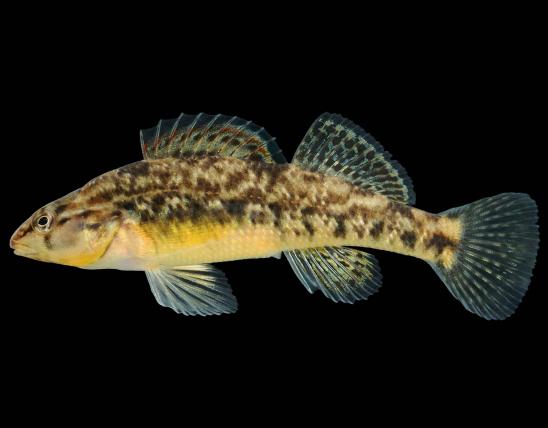
The orangethroat darter is one of the most common darters in the Ozarks. It is moderately stout, with 6–10 indistinct dark brown crossbars on the back. The overall color is mottled yellow brown on the back; the sides are lighter brown, often with several vertical blue bars or brown horizontal streaks.
Breeding males are brilliant, with alternating blue-green bars and brick-red blotches; the gill membranes are bright orange; the remainder of the undersurface of the head is blue-green; the belly sometimes has a patch of red; the fins are banded and spotted by blue-green and red.
This darter is variable, with different subspecies occurring in the state. One, for example is currently called the Ozark darter; taxonomically it is referred to the orangethroat darter "species complex," Etheostoma cf. spectabile. (The "cf." means "confer" or "compare with.") It is known only from the White River drainage system. It may, at some point, be formally described as a distinct species.
Total length: 1¼ to 2 inches; maximum about 2½ inches

Occurs throughout Ozarks and in tributaries of the lower Missouri and upper Mississippi rivers.
Habitat and Conservation
Occurs in slow-moving riffles in streams with gravel and rock bottoms and clear to moderately clear water. They are most active in daytime. The swim bladder in darters is lacking or much reduced. This allows them to sink and hold closely to the bottom of the stream without much effort.
Food
Midge larvae, aquatic sowbugs, and other aquatic insects and small crustaceans. Midge larvae are a favorite food, as are aquatic isopods (aquatic sowbugs). They use a roving search pattern, making frequent short moves and turns across the stream bottom, using head and eye movements to locate prey.
Status
This is one of the most frequently encountered darters over much of the Ozarks and in prairie tributaries of the lower Missouri and upper Mississippi rivers. Westward in the prairie sections, it is restricted to a few direct tributaries of the Missouri River. In the Bootheel lowlands, it occurs only in small creeks draining Crowley's Ridge.
Life Cycle
The orangethroat darter begins spawning earlier in the spring than the rainbow darter in Ozark streams, perhaps because it frequents small rivulets that warm more rapidly. Males move onto clean gravelly shoals and slow riffles as early as February. Spawning is often under way by mid-March and is completed by the last of May.
Frequently, early spawning is interrupted by cold snaps. Orangethroats desert the riffles when the temperature drops below 40 F.
Orangethroats generally spawn in slower current and lay their eggs in finer gravel than the rainbow darter. Females bury themselves in the gravel as spawning occurs. The eggs are mixed into the gravel and receive no parental care. They hatch in about 9 or 10 days.
Most breeding adult orangethroat darters are in their second or third summer of life, and few survive beyond their fourth summer. Males are slightly larger than females.
See "Ecosystem Connections" below for information on an interesting feature of the early life history of orangethroat darter.
Human Connections
Beautiful fish are to aquarium hobbyists as flowers are to gardeners. Nongame fishes may be collected for aquarium purposes by the holder of a fishing permit, using techniques and numbers specified for bait collecting in the Wildlife Code of Missouri. Be advised, however, that darters require live foods; some may be conditioned to eat frozen brine shrimp.
Ecosystem Connections
Shortly after hatching, orangethroat darter fry sometimes inhabit the nests of smallmouth bass. Many bass nests literally swarm with darters. It is believed that the young orangethroats benefit from the protection of the male bass guarding its nest; the full-grown bass will not feed on such "small fry." There may also be more of the preferred prey for the orangethroat fry in these locations, too.
Darters are small predators in the aquatic world, transforming the nutrients of insects and other small arthropods into a form (their own bodies) that is conveniently large enough for larger predators, including bigger fishes, birds, mammals, and reptiles.









































